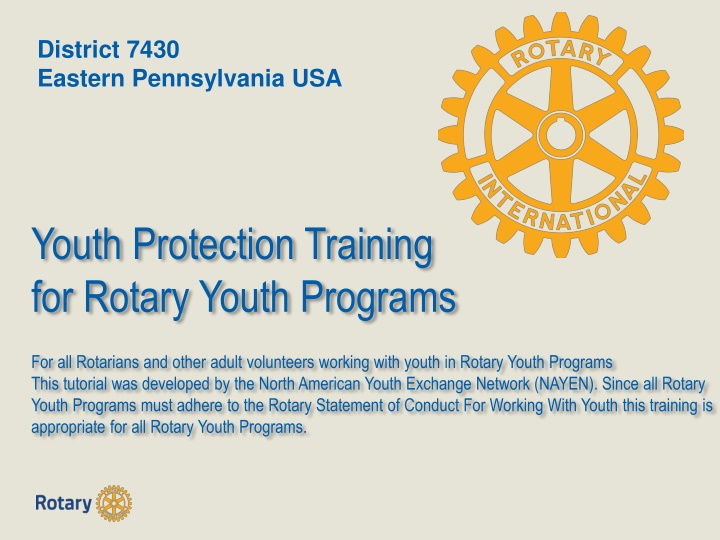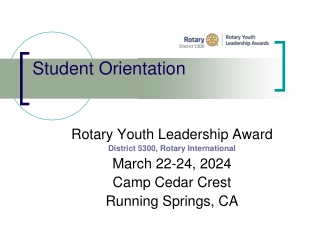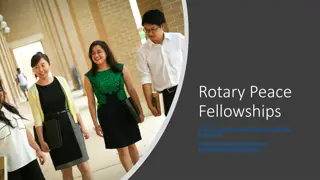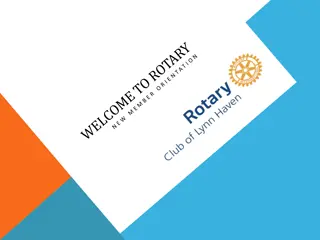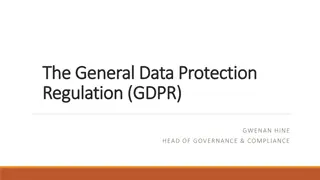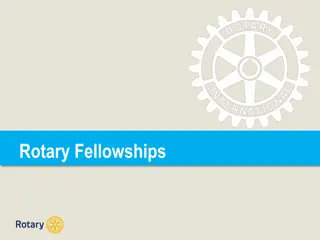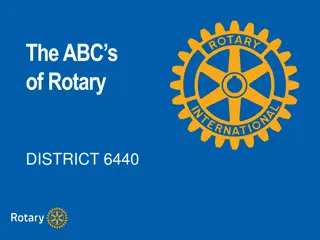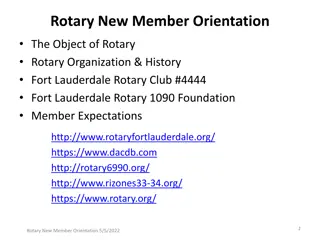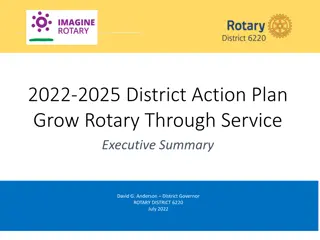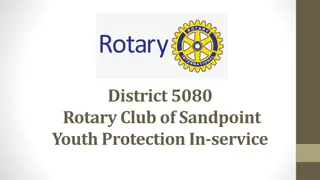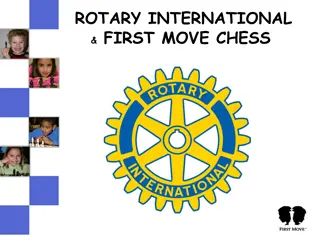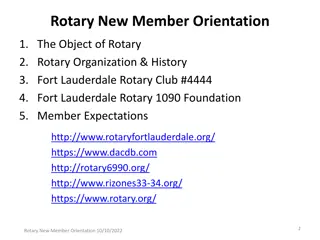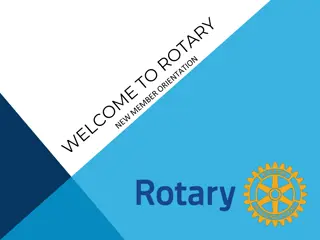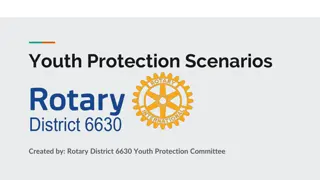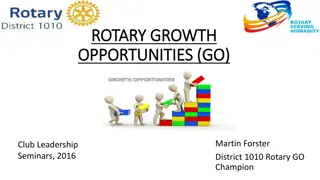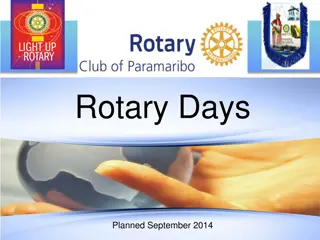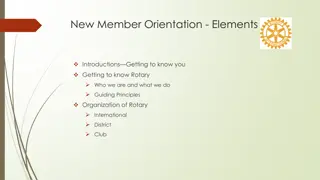Rotary Youth Program Youth Protection Training Overview
Rotary's Youth Protection Training tutorial provides guidelines for all adult volunteers working with youth in Rotary Youth Programs, emphasizing safety measures and adherence to the Statement of Conduct for Working with Youth. The training covers definitions, volunteer roles, abuse prevention, and more to ensure a secure environment for participating youth.
Download Presentation

Please find below an Image/Link to download the presentation.
The content on the website is provided AS IS for your information and personal use only. It may not be sold, licensed, or shared on other websites without obtaining consent from the author.If you encounter any issues during the download, it is possible that the publisher has removed the file from their server.
You are allowed to download the files provided on this website for personal or commercial use, subject to the condition that they are used lawfully. All files are the property of their respective owners.
The content on the website is provided AS IS for your information and personal use only. It may not be sold, licensed, or shared on other websites without obtaining consent from the author.
E N D
Presentation Transcript
District 7430 Eastern Pennsylvania USA Youth Protection Training for Rotary Youth Programs For all Rotarians and other adult volunteers working with youth in Rotary Youth Programs This tutorial was developed by the North American Youth Exchange Network (NAYEN). Since all Rotary Youth Programs must adhere to the Rotary Statement of Conduct For Working With Youth this training is appropriate for all Rotary Youth Programs.
Statement of Conduct for Working with Youth Rotary International strives to create and maintain a safe environment for all youth who participate in Rotary activities. To the best of their ability, Rotarians, Rotarians spouses, and partners, and other volunteers must safeguard the children and young people they come into contact with and protect them from physical, sexual, and emotional abuse. Adopted November 2006 (Rotary Code of Policies) Every adult who has a volunteer role in Rotary youth programs must indicate, in writing, their understanding of an agreement to adhere to the Rotary Statement of Conduct For Working With Youth. Rotary's Code of Policies contains an entire section on Youth Protection (you can download the document and search for 'Youth Protection'). TITLE | 2
Definitions Youth Throughout this training the below terms will be used interchangeably to mean youth : Youths Students Children Teenagers Young People In most cases, youth are minors, people under age 18. In some cases, such as in Youth Exchange, a youth may be age 18 or 19, but all of the policies and procedures in this tutorial apply to them as well, as if they were minors. TITLE | 3
Definitions Volunteers Who is a Volunteer? Any individual involved with Rotary Youth Program activities who has direct interaction, either supervised or unsupervised, with students is considered a volunteer. Volunteers include, among others: Club and District Youth Services Program Officers and committee members (including Interact Advisors and ROTEX) Youth Exchange and RYLA counselors Host parents and other adult residents of the host home, including siblings and other family members Individual Rotary Districts and Clubs also may have more specific definitions of what constitutes a volunteer. Please contact your local district or club for more specific information. TITLE | 4
Abuse and Harassment Abuse and harassment happen. No organization is invulnerable. Rotary takes youth protection very seriously. Any abuse or harassment is unacceptable. "Rotary International has a zero-tolerance policy against abuse and harassment". (Rotary Code of Policies, January 2019) TITLE | 5
Sexual Abuse and Sexual Harassment Sexual Abuse Sexual abuse refers to engaging in implicit or explicit sexual acts with a youth or forcing or encouraging a youth to engage in such acts alone or with anyone else, regardless of gender or age. Sexual abuse may also include non-touching activities, such as: Voyeurism Indecent exposure Photographing a young person while nude or partially nude, or in provocative poses Exposing a student to sexual or pornographic content, material or innuendo TITLE | 6
Sexual Abuse and Sexual Harassment Sexual Harassment Sexual Harassment consists of unwelcome visual, verbal or physical conduct of a sexual nature. It can also occur when a person in authority demands sexual favors or subjects a child/youth to sexual conduct that creates an offensive hostile, or intimidating environment. TITLE | 7
Sexual Abuse and Sexual Harassment Is it important to know the difference? For purposes of protecting students, and for purposes of reporting suspected abuse or harassment, it is not necessary to determine which is which. Both sexual abuse and sexual harassment are unacceptable and must be reported to authorities within the District s Rotary Youth Programs. The responsible District Rotary Youth Program official will report allegations to legal authorities and to RI when appropriate. TITLE | 8
Sexual Abuse and Sexual Harassment Signs and Symptoms of Abuse and/or Harassment Signs and symptoms of abuse and/or harassment can include, but are not necessarily limited to the following: Extreme activity or withdrawal Displays of low self-esteem Expressing general feelings of shame Fear, particularly toward certain individuals Declining school performance Eating disorders Insomnia Irritability or angry outbursts Difficulty concentrating TITLE | 9
Sexual Abuse and Sexual Harassment Signs and Symptoms of Abuse and/or Harassment Signs and symptoms of abuse and/or harassment can include, but are not necessarily limited to the following: Avoidance of people, places, and things that might remind one of an abusive incident Anxiety or depression Nightmares Headache, gastrointestinal distress, or abdominal, back, or pelvic pain Suicidal thought Involvement with drugs or alcohol Aggressive/risk-taking behavior or antisocial behavior These signs and symptoms can also be indicative of a wide variety of other problems. TITLE | 10
Sexual Abuse and Sexual Harassment Sexual Abuse and Harassment are Behaviors Perpetrators of sexual abuse and harassment are responsible for their behavior and for its consequences. Can training change the behavior of abusers/offenders? Yes, increasing awareness can reduce the incidence of sexual abuse and harassment in Rotary youth programs. TITLE | 11
Sexual Abuse and Sexual Harassment How Common are Sexual Abuse and Sexual Harassment? Sexual harassment is common throughout workplaces, school campuses, and communities and in all occupations and professions. It can be perpetrated by persons from all educational backgrounds, grade levels, ages, racial and ethnic groups, and income levels. While the majority of reported cases of sexual harassment involve a male harassing a female. Cases can also involve a female harassing a male, or men or women harassing members of their own gender. TITLE | 12
More Facts About Sexual Abuse Young people often fail to report sexual abuse. NOTE: This is especially true in Youth Exchange Child abuse is often underreported. Many victims don t report until they are adults. Fewer than 4% of sexual abuse allegations prove to be false. Children tend to minimize and deny abuse. Child sex offenders seek opportunities for access to children. One in ten young people will be affected at sometime. Two-thirds of all sexual abuse happens to children under 18. Nearly 90% of the time the student knows the abuser. Most women know their perpetrator. 30-50 percent of offenders are under age 18. In most countries, sexual assault is the most under-reported crime. TITLE | 13
Who are sexual offenders? The field of sexual child abuse often involves pedophiles. A pedophile is a certain type of predator who is attracted to sexual activity with pre- pubescent children. Pedophilia is a serious and largely untreatable disorder. Sexual offenders in Youth Exchange, RYLA and Interact are unlikely to be pedophiles because participants are teenagers who have reached puberty. Potential offenders are, however, predators, who seek opportunities for sexual activity where they should not. Most sexual offenders in Rotary Youth Programs will not have a criminal background and are likely to be first-time offenders. They are generally otherwise law-abiding citizens. Sexual Offenders will often be deterred from seeking inappropriate contact with students by means of Rotary s preventive policies and procedures. TITLE | 14
Hostile Environment In legal terminology, a hostile environment is one in which unwelcome conduct of a sexual nature creates an intimidating, offensive or disruptive work or school environment for one or more individuals. Examples of this conduct may include sexually explicit communication (face-to-face, electronic, or written). Other examples may be sharing sexually provocative images, making comments about physical attributes, or inappropriate touching. These same principles may apply in settings in the home or community where a Rotary youth may spend time. It is important to understand this concept. Even mild instances of sexual content (in talk, music, print, video, TV, and so on) which may appear to be minor on their own, may cumulatively create a harassing environment if there is a pattern of such activities. TITLE | 15
Hostile Environment The following example could be construed as hostile school environment sexual harassment: Mandy has a habit of leaning in close to Rachel and brushing her hand against Rachel's thighs when they are working on a group assignment or in lab. Rachel has brushed her away and asked her to stop several times, but Mandy continues to annoy her. Mandy and Rachel are peers, so this behavior may be considered hostile environment sexual harassment. Remember, however, that if the offender is an adult and the target is a minor, the behavior could be an example of sexual abuse. TITLE | 16
Forms of Sexual Abuse and Harassment Sexual Abuse/Harassment may take many forms Verbal Derogatory comments of a sexual nature or comments based on gender Personal comments about a person's body or attractiveness Sexual or gender-based jokes or teasing Requests for sexual favors Requests to a minor for dates or for inappropriate time alone with the adult Sexual innuendoes and stories TITLE | 17
Forms of Sexual Abuse and Harassment Sexual Abuse/Harassment may take many forms Verbal Grunts, whistles, catcalls, hoots, sucking noises, lip-smacks and animal noises Tales of one's partner's sexual inadequacies or prowess Tales of sexual exploitation Graphic descriptions of pornography or sexual fantasies Obscene phone calls or emails Transmission of emails, text messages, tweets, blogs or social networking of a sexually graphic, threatening or vulgar nature Lies or rumors about a person's personal or sex life TITLE | 18
Forms of Sexual Abuse and Harassment Sexual Abuse/Harassment may take many forms Non-Verbal Staring Eyes wandering over a person's body Making derogatory gestures of a sexual nature Giving sexually suggestive looks Making facial expressions of a sexual nature: winking, licking lips TITLE | 19
Forms of Sexual Abuse and Harassment Sexual Abuse/Harassment may take many forms Visual Posters, cartoons, drawings, calendars, and photos of a sexual nature Computer graphics of a sexual nature Digital images depicting nudity, sexuality or sexual activity sent by computer, phone or any social media Inappropriate, sexually expressive or revealing clothing Pornographic publications, videos, TV, movies or other displays Sexual toys and any other objects of a sexual nature TITLE | 20
Forms of Sexual Abuse and Harassment Sexual Abuse/Harassment may take many forms Physical Leaning over or into someone's personal space or comfort zone (often defined by one's culture) Inappropriately or frequently touching a person or person's clothing Brushing against sexual parts of the body, including breasts Indecent exposure, mooning or flashing Blocking someone's path TITLE | 21
Forms of Sexual Abuse and Harassment Sexual Abuse/Harassment may take many forms Physical Uninvited massaging Touching of a deliberately sexual nature Pressing or rubbing up against a person Stalking Grabbing, holding or otherwise inhibiting freedom of movement Kissing, hugging, patting, stroking, pinching Actual or attempted sexual assault TITLE | 22
Different Perspectives There can be different perspectives from which individuals view a situation. These perspectives can be influenced by the following: Gender Country of origin Culture Age Religion Personal Values These can affect how an individual feels about such things as: Nudity Physical Touch Personal Space Eye Contact TITLE | 23
Avoiding Offensive Behavior How can you know in advance if a behavior will be unwelcome or offensive? Here are some general guidelines to avoid engaging in unwelcome behavior: Respect everyone around you. Think before acting. Imagine how other people might be feeling. Be sensitive to diverse perspectives, cultural differences and language variations. Exercise common courtesy and respect. Think twice before making a joke. TITLE | 24
Avoiding Offensive Behavior How can you know in advance if a behavior will be unwelcome or offensive? Here are some general guidelines to avoid engaging in unwelcome behavior: Some questions to ask yourself are: How would I feel if I were being treated this way? Would my child, spouse, relative, or friend like to be treated this way? Would I like my behavior posted on the Internet? Could my behavior be offensive, hurtful or threatening? Could someone misinterpret my behavior as intentionally harmful or harassing, when that is not my intent? If you are unsure if something might be welcome, don't do it. Always keep in mind the impact of your words or actions on the other person. TITLE | 25
The Myth of Intent Your intent is not relevant ... Only your actions are meaningful Is the behavior offensive to the other individual? Is the behavior appropriate with a minor? I didn t mean anything by it is not a valid defense Example Joey loves to tell funny stories to friends and classmates. He tells a story to a group of friends. Megan looks offended and moves away hurriedly. Joey didn't mean any harm, but what one person may intend as genuine friendship (even if in a clumsy way) may be perceived quite differently by another. TITLE | 26
Abuse of Power or Trust by "Authority Figures" Authority Figures Authority figures are individuals, frequently in the everyday lives of youth, and are in a position of responsibility for their welfare. The authority they hold is used to direct, guide and supervise the youth for whom they have responsibility. With this authority comes a sense of trust that the person in authority has the youth's best interest at heart. Youth generally find such authorities trustworthy. Unfortunately, among those authority figures, there can be sexual predators who take advantage of their positions, and the resulting sense of trust, to groom and eventually harass or abuse the very youth for whom they are responsible. TITLE | 27
Abuse of Power or Trust by "Authority Figures" Authority Figures The following are some examples of authority figures who might be present in a youth's life: Parents Neighbors Coaches Teachers Tutors Clergy School officials Rotarians Host Parents Host Family friends TITLE | 28
Peer-to-Peer Harassment Sexual harassment can involve people of different ages or unequal authority. Sexual harassment which happens between persons of the approximate same age and of equal authority is called "Peer-to- Peer Harassment". Peer-to-peer harassment, such as may happen between students or friends, can sometimes be stopped by the victim. Directly and clearly requesting that the offender stop the behavior can be effective, and students may feel comfortable handling these situations by themselves. If the request to the offender does not stop the behavior, the next step for the student is to ask a trusted adult to intervene. This is one reason that it is important for Rotarians in Rotary Youth Programs to establish safe, trusting relationships with their youth. Once aware of the situation, any adult associated with a Rotary activity is obligated to report the incident. TITLE | 29
Third-Party Harassment Sexual harassment can involve people of different ages or unequal authority. Sexual harassment which happens between persons of the approximate same age and of equal authority is called "Peer-to- Peer Harassment". Peer-to-peer harassment, such as may happen between students or friends, can sometimes be stopped by the victim. Directly and clearly requesting that the offender stop the behavior can be effective, and students may feel comfortable handling these situations by themselves. If the request to the offender does not stop the behavior, the next step for the student is to ask a trusted adult to intervene. This is one reason that it is important for Rotarians in Rotary Youth Programs to establish safe, trusting relationships with their youth. Once aware of the situation, any adult associated with a Rotary activity is obligated to report the incident. TITLE | 30
Third-Party Harassment Persons offended by sexual language or behavior need not be direct participants or targets of the behavior. Youth involved in Rotary Youth Programs are not in an entirely free and voluntary environment and are therefore potentially subject to third-party harassment. Example: At your club meeting, a student is attending a meeting. A Rotarian at her table tells an off-color joke, and the youth is offended. This is third-party sexual harassment. Example: Your Rotary Club has a booth at a local event to get the word out about Rotary and try and attract new members. One of the Rotarians who is manning the booth makes a comment to the other regarding the physical appearance of a young woman as she walks by the booth. Two Interact students who were standing nearby overheard the comment and were offended. This is also third-party sexual harassment. TITLE | 31
Receiving a Report of Harassment or Abuse If you are the first adult volunteer to whom a student comes with a report of abuse or harassment, follow these guidelines: Listen attentively and stay calm. Assure privacy but not confidentiality. Get the facts, but don't interrogate. Be non-judgmental and reassure the youth. Keep a written record of the conversation. Ensure the safety and well-being of the youth. Do not, under any circumstances, attempt to contact the alleged offender. TITLE | 32
Receiving a Report of Harassment or Abuse Confidentiality Assure privacy, but not confidentiality for the following reasons: Some people need to know . Those involved need to be interviewed. There can be law enforcement involvement. TITLE | 33
Other Discriminatory Harassment Any harassment based on discrimination, including but not limited to age, gender, sexual orientation, race, religion, or disability is unacceptable in Rotary programs TITLE | 34
Youth Protection in Rotary Youth Programs This course is one of many that are intended to protect youth from sexual and other abuse or harassment in Rotary Youth Programs. Below are active measures within Rotary Policies and Procedures intended to prevent abuse and harassment: For All Rotary Youth Programs Volunteer Agreement Form Training and orientation Background checks Reference checks Personal interview Zero-tolerance policy TITLE | 35
Youth Protection in Rotary Youth Programs This course is one of many that are intended to protect youth from sexual and other abuse or harassment in Rotary Youth Programs. Below are active measures within Rotary Policies and Procedures intended to prevent abuse and harassment: For Youth Exchange Rotarian counselors Non-Rotarian Counselors Counselor not a host family member Written Host Family Application Multiple home visits Multiple host families All host family members present during the home visit TITLE | 36
Core Elements of Youth Protection The following are the core elements that have been adopted by participating DISTRICT 7430 and its Rotary Clubs to provide security for youth; in addition, they serve to protect Rotarians from situations in which they are vulnerable to allegations of abuse or harassment. Two-deep leadership. Two Rotarian adult leaders or one Rotarian leader, a teacher or a parent-both of whom are 21 years of age or older-are required on all activities, trips and/or outings. If the activity is co-educational, leaders of both sexes must be present. The participating organization is responsible for ensuring that sufficient leadership is provided for all activities. No one-on-one contact. One-on-one contact between adults and participants is not permitted unless : The adult (over 18 yrs of age) is a Volunteer participant in the Rotary Youth program, such as a District Committee member, a Club coordinator or counselor where the adult has submitted an extended Volunteer application and has been vetted extensively, including three separate references, and has undergone an extended national criminal background check TITLE | 37
Core Elements of Youth Protection Youth Program Volunteers - shall resubmit full volunteer applications every three years but criminal background shall be conducted annually. Respect of privacy. Adult leaders must respect the privacy of participants in situations such as changing into swimsuits or taking showers at activities and intrude only to the extent that health and safety require. They must also protect their own privacy in similar situations. Separate accommodations. When attending overnight events, no youth is permitted to share a room with an adult other than their parents or guardians. Proper preparation for high-adventure activities. Activities with elements of risk should never be undertaken without proper preparation, equipment, supervision, and safety measures. TITLE | 38
Core Elements of Youth Protection No secret organizations. There are no secret organizations recognized in Rotary. All aspects of Rotarian programs are open to observation by parents and leaders. Constructive discipline. Discipline should be constructive and reflect the program s underlying values. No Corporal punishment. Hazing is prohibited. Physical hazing and initiations are prohibited and may not be included as part of any Rotary activity. Youth leader training and supervision. Adult leaders must monitor and guide the leadership techniques used by youth leaders. TITLE | 39
Reporting Guidelines Information Listen attentively and stay calm. Acknowledge that it takes a lot of courage to report abuse. It is appropriate to listen and be encouraging. Do not express shock, horror, or disbelief. Assure privacy but not confidentiality. Explain that you will have to tell someone about the abuse/harassment to make it stop and to ensure that it doesn t happen to others. Get the facts, but don t interrogate. Ask questions that establish what was done and who did it. Reassure the young person that he or she did the right thing in telling you. Avoid asking why questions. Remember your responsibility is to present the story to the proper authorities. Be non-judgmental and reassure the youth participant. Do not be critical of anything that has happened or anyone who may be involved. It is especially important not to blame or criticize the young person. Assure the young person that the situation was not his or her fault and that he or she was brave and mature to come to you. TITLE | 40
Reporting Guidelines Information Record. Keep a written record of the conversation as soon after the report as you can, including the date and time of the conversation. Use the young person s words, and record only what has been told to you. Contact youth protection officers and contact legal authorities when abuse is alleged. Rotarians and other adults involved in youth programs are not trained professionals with expertise in determining the seriousness or legal implications of an allegation; therefore, they should not decide whether an allegation constitutes abuse or harassment unless the decision is made in close consultation with youth protection service agencies, law enforcement, or a district youth protection officer trained in handling allegations of abuse or harassment toward young people. Report to Rotary contact. Inform your Rotary contact either the District Youth Protection Officer, District Youth Programs Chair, or District Governor who then will then contact and file an Incident Report RI within 72 hours. TITLE | 41
District 7430 Eastern Pennsylvania USA Thank You You have completed D-7430 s Youth Protection Training If you have any questions, please contact the D-7430 Youth Protection Officer When you have completed the module, please email District Administrator Sharon Rittenhouse, she will update your volunteer record to confirm you have completed training rittenhousesharon@gmail.com
